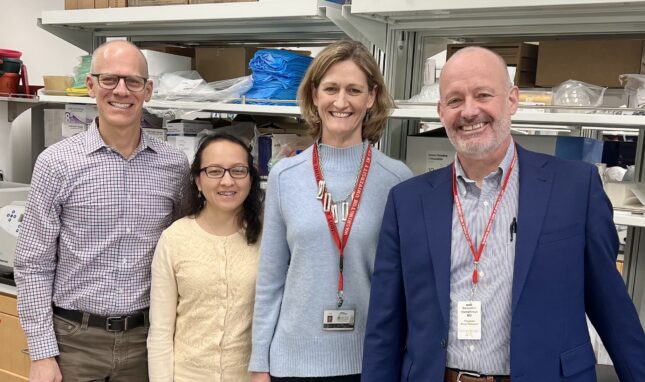
The recently established Washington University Kidney O’Brien Center for Chronic Kidney Disease Research has its first publication. Haojia Wu, PhD, Assistant Professor of Medicine, WashU Nephrology, is first author of the article “High resolution spatial profiling of kidney injury and repair using RNA hybridization-based in situ sequencing,” published in Nature Communications (volume 15, article number: 1396, Feb 2024).
Although several single-cell multi-omic analyses have greatly advanced the understanding of kidney cell states both in healthy and diseased kidneys, the protocols require cellular or nuclear dissociation. Unfortunately, this results in the loss of spatial information and precludes a full analysis of how cells interact with each other in their tissue microenvironment.
Recent advances in spatial transcriptomic technologies, however, have begun to allow high-throughput quantification of RNAs within an intact tissue section. Dr. Wu, who conducts research in the laboratory of Benjamin Humphreys, MD, PhD, the Joseph Friedman Professor of Renal Diseases in Medicine and Chief of the Division of Nephrology, developed a computational tool called CellScopes, which enables rapid analysis and visualization of spatially resolved transcriptomic data sets.
In the Nature Communications study, the CellScopes tool was used to create a high-resolution spatial “map” of kidney cell types during injury and repair using direct RNA hybridization-based in situ sequencing (dRNA HybISS). It revealed fine kidney structures, cell marker expression patterns, and how the spatial expression patterns of the disease signature change during acute kidney injury. The insights into the cellular dynamics of kidney injury and repair should prove valuable in guiding future therapeutic strategies.
“Existing tools for spatial transcriptomics analysis were not specifically designed for kidney research. This gap prompted us to develop CellScopes, a tool tailored for analyzing and visualizing kidney spatial data. We hope that CellScopes will be a valuable resource for researchers aiming to analyze their spatial transcriptomics data.”
Haojia Wu
Please read more about this exciting and important study by Dr. Wu and collaborators in the feature article of our Spring 2024 Nephrology Update Alumni Newsletter.
Read the full scientific article in Nature Communications here (authors: Haojia Wu, Eryn E. Dixon, Qiao Xuanyuan, Juanru Guo, Yasuhiro Yoshimura, Chitnis Debashish, Anezka Niesnerova, Hao Xu, Morgane Rouault and Benjamin D. Humphreys).
CellScopes.jl, a Julia programming language package for analyzing various spatial transcriptomics data, is available at the Humphrey’s lab GitHub account.
The Kidney O’Brien Center at WashU Nephrology, which is headed by Dr. Humphreys, was established to provide the kidney research community better access to cutting-edge technologies, resources, and training to study chronic kidney disease. The program is funded by a five-year $4.5 million grant from the National Institute of Diabetes and Digestive and Kidney Diseases of the National Institutes of Health and is part of the network of O’Brien National Resource Centers. Learn more about the Center here.

On X, follow @HaojiaWu, @HumphreysLab and @WUNephrology; visit and “Like” us on Facebook.